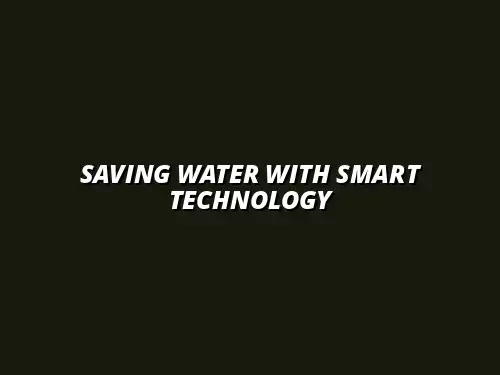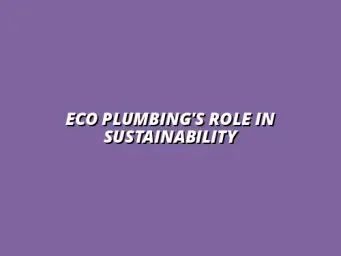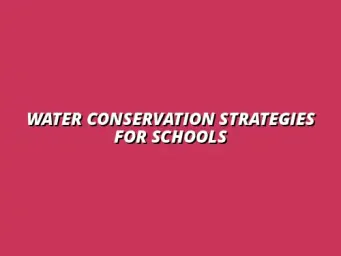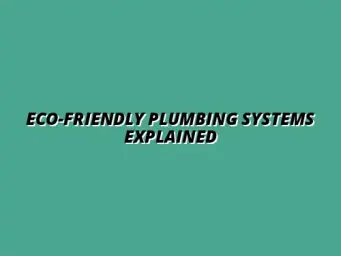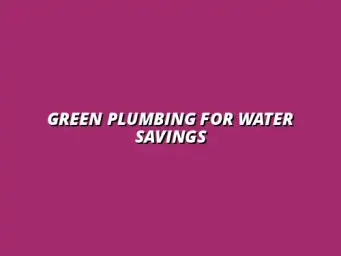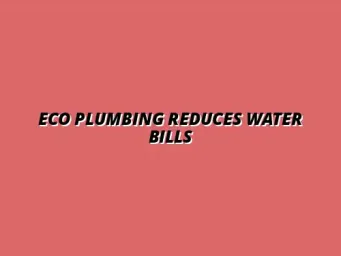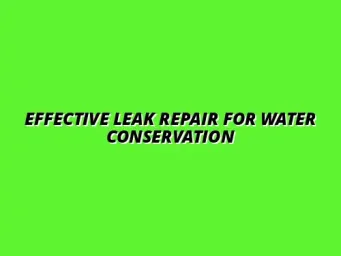Understanding Water-Saving Technologies and Their Importance
Water is a precious resource that we often take for granted. As our population grows and climate change impacts water availability, the need for water-saving technologies has never been more crucial. These technologies not only help conserve water but also ensure that it is used efficiently in our daily lives. For practical tips on reducing water waste in your daily routine, check out these daily tips for water conservation.
In essence, water-saving technology refers to methods, devices, and systems designed to reduce water usage while maintaining functionality. By adopting these technologies, we can better manage our water resources, making a significant difference in addressing global water challenges.
Defining Water-Saving Technology in Our Daily Lives
What constitutes water-saving technology?
Water-saving technology encompasses a variety of innovations that minimize water usage across different sectors. This can include everything from smart fixtures to advanced irrigation systems. The primary goal of these technologies is to achieve the same results—like cleaning, cooking, or gardening—while using less water. Learn more about how to conserve water in your bathroom with these helpful bathroom plumbing tips.
By integrating these technologies into our lives, we can actively participate in conserving this vital resource. It’s our responsibility to understand these tools and embrace their benefits for both our homes and the environment.
Examples of water-saving devices and systems
- Low-flow showerheads: Reduce water flow without sacrificing pressure.
- Dual-flush toilets: Offer two flushing options to save water.
- Drip irrigation systems: Deliver water directly to plant roots efficiently.
- Rain barrels: Collect rainwater for landscaping and gardening.
These examples represent just a few ways we can integrate water-saving technologies into our daily routines. Each of these devices plays a vital role in not only reducing consumption but also promoting environmental stewardship. For comprehensive kitchen plumbing maintenance, including water-saving practices, see these essential tips.
The Impact of Water Scarcity on Global Consumption
Statistics on water scarcity and its implications
Water scarcity is a growing concern worldwide, affecting billions of people. According to recent estimates, around 2 billion people live in countries experiencing high water stress. This worrying statistic highlights that our water resources are becoming increasingly strained.
The implications of water scarcity are far-reaching. It can lead to food shortages, increased health risks, and economic challenges. Understanding these impacts is essential for recognizing the importance of implementing water-saving technologies in our lives. Discover the significant benefits of eco-friendly plumbing for homeowners by clicking here.
How reducing water consumption can alleviate shortages
Reducing water consumption can significantly help to alleviate the stress on our water supply. By adopting water-saving technologies, we can:
- Lower overall demand: Using less water means fewer resources need to be extracted and treated.
- Protect ecosystems: Conserving water helps maintain natural habitats and biodiversity.
- Enhance resilience: Communities can better withstand droughts and other climate impacts.
By committing to reduce our water use, we contribute to a more sustainable future and ensure that water remains available for generations to come. Every drop counts!
Addressing Common Questions About Water-Saving Technologies
Many people wonder how technology can actually help us save water. The truth is, water-saving technologies employ various mechanisms to monitor, manage, and minimize our water usage. These systems often rely on advanced sensors and data analytics that track consumption patterns, allowing for timely interventions and adjustments. Regular water heater maintenance is also crucial for efficient water usage.
For instance, smart irrigation systems can automatically adjust watering schedules based on weather conditions. This means less water is wasted while ensuring plants receive exactly what they need!
How does technology contribute to reducing water consumption?
To really understand how these technologies work, let’s look at some specific features they offer. They often include:
- Real-time monitoring: Sensors that track water flow and usage.
- Automated controls: Systems that adjust water delivery based on need.
- Data-driven insights: Analytics that help identify wasteful practices.
In real-life scenarios, these technologies have shown significant reductions in water consumption. For example, homeowners using low-flow showerheads can save up to 40% more water compared to standard models. Similarly, farms adopting precision irrigation have reported up to a 50% reduction in water usage while maintaining crop yields! For more water saving tips specific to your home, visit this page.
Understanding the mechanisms of water-saving technology
Water-saving technologies often incorporate various elements that contribute to their success. Key mechanisms include:
- Soil moisture sensors: These help determine when plants actually need watering.
- Smart timers: Devices that schedule watering based on specific criteria.
- Flow rate regulators: These ensure that only the necessary amount of water is used.
By leveraging these tools, we can make more informed choices about our water consumption, ultimately leading to a healthier planet!
What role does government play in promoting water-saving technologies?
Governments play a crucial role in encouraging the adoption of water-saving technologies through policies and programs. They often provide incentives to individuals and businesses to make the switch to more efficient systems. These incentives can take various forms, including:
- Tax credits: Financial benefits for purchasing water-efficient devices.
- Subsidies: Reduced costs on installations for water-saving systems.
- Grant programs: Funding for innovative water conservation initiatives.
In addition to incentives, regulations can also push for better practices. For example, many regions now mandate the installation of low-flow fixtures in new buildings to encourage responsible water use. If you need a plumber in Billesley, Birmingham for installation or repair, contact this plumber.
Incentives and regulations for adopting water-saving devices
Community programs can significantly enhance the effectiveness of these efforts. They often focus on educating the public about the benefits of water conservation and how to implement changes in their daily lives. Some successful community initiatives include:
- Workshops: Sessions where residents learn about water-saving technologies.
- Neighborhood challenges: Competitions that encourage families to reduce their water usage.
- Resource sharing: Local libraries providing tools and devices for community use.
These programs not only raise awareness but also foster a culture of conservation among community members!
Future Trends in Water-Saving Technologies
As we look toward the future, emerging innovations in water management are gaining momentum. Technology is evolving rapidly, and new tools are being developed to address water conservation in even more effective ways. Smart home technologies, for example, are becoming increasingly popular!
Emerging Innovations in Water Management
The Internet of Things (IoT) is playing a vital role in this transformation. With connected devices, homeowners can manage their water usage more efficiently, leading to significant savings. Notable innovations include:
- Smart meters: Devices that track water use in real-time, providing valuable insights.
- Leak detection systems: Technology that alerts homeowners to leaks immediately.
- Water usage apps: Applications that help users monitor and control their consumption.
The potential of artificial intelligence (AI) is also significant. AI can analyze large sets of data to optimize water usage further, tailoring solutions to meet specific needs!
Smart home technology and IoT applications for water conservation
As these technologies develop, individuals and businesses must be proactive in leveraging them for maximum benefit. Implementing water-saving technologies now can lead to long-term savings and a more sustainable future. Steps include:
- Choosing efficient fixtures: Install low-flow faucets and showerheads.
- Upgrading appliances: Replace old washing machines with energy-efficient models.
- Utilizing smart systems: Incorporate smart irrigation and monitoring tools.
By making these choices, we can collectively contribute to a healthier planet while enjoying the benefits of lower water bills!
Strategies for Individuals and Businesses Moving Forward
As we adopt these technologies, it’s essential to encourage a culture of conservation in our local communities. This can be achieved through various strategies:
- Education campaigns: Informing residents about the importance of saving water.
- Community events: Organizing clean-up days and water conservation awareness activities.
- Partnerships: Collaborating with local organizations to promote water-saving initiatives.
By working together, we can create a significant impact in our neighborhoods and beyond!
Steps to implement water-saving technologies at home and work
It’s time for all of us to take action! Whether at home or in the workplace, implementing water-saving technologies is crucial for sustainable consumption. Here are a few actionable steps:
- Conduct an audit: Assess current water usage to identify areas for improvement.
- Invest wisely: Choose technologies that align with your needs and budget.
- Monitor progress: Keep track of water savings and adjust strategies as needed.
Every small change counts, and together, we can make a big difference!
Final Thoughts on Water-Saving Technology and Sustainable Consumption
In summary, water-saving technologies offer numerous benefits that extend beyond just conserving water. They help protect our environment, reduce costs, and promote sustainable practices within our communities. By understanding the importance of these technologies, we can all contribute to a more sustainable future.
Summarizing the Benefits of Water Conservation Technology
Using water-saving technology not only alleviates the pressure on our water resources but also provides long-term economic advantages. Some key benefits include:
- Lower bills: Reduced water usage directly translates to savings on utility costs.
- Enhanced property value: Eco-friendly features can increase the value of homes and businesses.
- Environmental impact: Less water consumption helps protect local ecosystems.
As we embrace these innovations, we also become more responsible stewards of our planet!
Community impact and global responsibility
Ultimately, it’s about making choices that benefit our communities and the world at large. By adopting water-saving technologies, we foster a culture of conservation that inspires others. Together, we can make a meaningful impact on our environment!
Encouraging Action: How Readers Can Contribute to Water Conservation
There are many ways readers can actively participate in water conservation efforts. Personal commitments can include:
- Setting goals: Aim to reduce your household water usage by a specific percentage.
- Participating in local programs: Join community initiatives focused on conservation.
- Spreading awareness: Share tips and knowledge with friends and family.
By taking these steps, we can all contribute to a more sustainable future!
Resources and tools for further learning and action
If you’re eager to learn more, there are various resources available to help guide your water conservation journey. Consider exploring:
- Online courses: Many platforms offer free courses on sustainability and water management.
- Local workshops: Check community centers for events focused on conservation practices.
- Government resources: Visit your local government website for information on water-saving programs.
With the right tools and knowledge, we can all make a positive difference in our communities and beyond!

